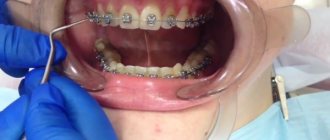Is it possible to correct an overbite?
In fact, there are only a few treatment options for maxillofacial pathologies. They can be used individually or in combination.
Surgical treatment will be the most effective. After the operation, the conscript can try to join the army again only after a 6-month rehabilitation period.
If during this time you manage to get rid of the defect, then the treasured summons to enlist in the army will be in your hands! If a conscript cannot or does not want to solve bite problems, then he is assigned fitness category “B”.
An equally exciting question directly related to malocclusion and the army, which is often asked by clients of the Military Bar Association, is whether it is possible to get into the army with braces. Of course, wearing braces is not a reason to refuse a summons.
Despite the fact that braces require constant care, and specialists must correct the teeth straightening process, this does not become a reason for postponing military service.
The only reason that is acceptable for a delay is surgical intervention to correct problems with a 2-3 degree bite and a defect of more than 10 mm. If the conscript decided to simply correct deficiencies in the appearance of his teeth by installing braces, then this is not considered a valid reason for avoiding service.
Sometimes representatives of the military commission still make concessions, but such cases are too rare.
The conscript has only one thing left to do - make a decision to stay in braces without providing the systems with the necessary care, especially during military field practice. Or remove the braces to fully perform all tasks without worrying about providing proper care with systems to correct bite problems.
This is important to know: How to get a combat veteran ID
If you have any doubts about whether you can count on exemption from the army or service without restrictions due to your health condition, it is better to consult with an experienced military lawyer who will help you understand the nuances and develop the right course of action.
Possible problems with braces during service
Those who are declared fit for combat due to health reasons and decide to serve with braces face the following inconveniences and difficulties:
- limiting the time and possibility of proper oral care - cleaning, rinsing;
- inability to choose a diet, standard food;
- lack of opportunity for periodic professional activation and installation of braces;
- there is a high probability of injuries to the maxillofacial area, and with the presence of a dental arch they can be more severe.
Important!
You should take these aspects into account in order to make your own decision about removing braces, because according to the law, no one has the right to oblige a conscript to do this.
Deep bite - do they take you into the army?
Expert opinion
Davydov Dmitry Stanislavovich
Deputy Head of the Military Commissariat
Whether one is recruited into the army with an overbite (deep, distal, open or crossbite) depends on the degree of the defect. Article 56 of the Schedule of Diseases states that a conscript has the right to be exempt from military duty in two cases:
- Anomaly of 2 degrees with separation of 5-10 mm. with chewing activity less than 60%.
- Anomaly of 2 or 3 degrees with separation of more than 10 mm.
Non-conscription forms of occlusion are immediately visible, so the dentist at the military commissariat should send you for additional examination. With its help, the degree of bite and chewing activity will be determined. If the non-conscription diagnosis is confirmed, the draft commission will approve your category “B” and give you a deferment from conscription for treatment.
Treatment of maxillofacial pathology includes both individual listed methods and their combination. In case of surgical intervention, recruitment is possible no earlier than 6 months after the operation. If the problem is resolved during this time, the military commissariat will give you a summons to dispatch.
If medical intervention is refused, category “B” is assigned.
List of documents for deferment
If a conscript has the above malocclusions, he must inform the draft commission about this and submit the necessary documents.
The deferment from military service in this case is temporary. The release ends when the correction of the malocclusion is completed.
The set of required documents includes:
- Conscript's medical card.
- Conclusion of the attending physician.
- X-ray confirming the defect.
After reviewing all the documents, the conscript is examined by a military dentist. In addition, a consultation with an outside orthodontist is scheduled.
After the diagnosis is confirmed, the conscript is given temporary release. This decision is based on the fact that such anomalies interfere with chewing food, and no one will grind it. Also, an incorrect bite impairs diction, and in the army clarity of speech is required.
During the commission, the conscript can also receive recommendations for further treatment.
Let's find out what to do if you swallow a brace, and why it is dangerous.
In this publication we will discuss whether it is possible to do an MRI of the head with braces.
Here https://www.vash-dentist.ru/ortodontiya/breketyi/vse-za-i-protiv-sposobov-fiksatsii.html we will consider the pros and cons of the indirect method of fixing braces.
Will they be accepted into the army with braces in 2020?
Installing braces is an expensive procedure that requires careful attention to the treatment process. A person must undergo periodic examinations by an orthodontist and regularly care for the structure: brushing teeth after each meal, using dental floss and other hygiene products.
In the army, such care is not always possible. If, while in a military unit, a conscript has some opportunity to take care of brace systems, then while he is in field exercises, he will have to forget about care. However, this fact does not give young people the right to be exempt from conscription or to evade teaching.
Even if a conscript has braces, he is not entitled to a deferment from the army. There is no article in the Schedule of Diseases guaranteeing the right to temporary or complete exemption from military duty when installing such structures.
The only exception is if surgical treatment is used to correct a 2nd degree malocclusion with a separation of 5-10 mm and chewing activity of less than 60% or a 2-3 degree malocclusion with a separation of more than 10 mm.
Treatment to correct a cosmetic defect is not a reason for granting a deferment or enlistment. In some cases, members of the military medical commission may accommodate the conscript and give him time to complete treatment. However, this depends solely on the personal attitude of the doctors.
When sent to the army, a conscript should think about how the installation of braces will affect his stay in the military unit, and whether he will be able to provide the necessary care. In some cases, the only correct solution will be to remove the structure.
However, the conscript must make a decision about this independently. Members of the military medical or draft commission do not have the right to demand that a citizen remove braces.
With respect to you, Ekaterina Mikheeva, head of the legal department of the Assistance Service for Conscripts.
Is there a delay when installing braces?
Many people are interested in the question of whether there is a delay in installing braces and what needs to be done to get it.
A deferment for the placement of braces can only be issued if the conscript has a second-degree malocclusion with a separation of at least 5 mm and a chewing activity of less than 60%.
In order to obtain a deferment, you must submit the relevant documents to the medical commission, and after reviewing them, the medical commission will make the necessary decision.
Malocclusion and the army - theory and practice
Malocclusion and the army are an ambiguous combination. With such a diagnosis, they can be sent to serve or given release.
Depends on the severity of the defect, the degree of impairment of chewing function. The anomaly is visible to the naked eye, so no additional examination is required to confirm the diagnosis.
This is important to know: Are they recruited into the army with mitral valve prolapse?
The commission can make a decision based on an examination and entries in the pre-conscript’s medical card.
How to determine the degree of malocclusion
This term refers to the incorrect arrangement of teeth in a closed state. The defect, in most cases acquired, often develops in the first year of the baby's life. As you get older, the situation gets worse.
The main causes of malocclusion include:
- Artificial feeding using a pacifier, sucking a pacifier.
- Incorrect head position during feeding and sleeping.
- A bad habit is thumb sucking.
- Frequent diseases of the nose - sinusitis, congestion. The child breathes through the mouth, an incorrect taste is formed, and an “adenoid” type of face develops.
- Genetic data - heredity.
In addition, one of the main reasons for the formation of malocclusion is abnormal tooth growth. If you do not respond to the problem in a timely manner, the jaw and face as a whole become distorted. In this case, braces are used to correct the bite.
Types and classification of abnormal bite:
- Mesial, medial . It can be true or false. It is determined by the advancement of the lower jaw relative to the upper. One of the most difficult anomalies, practically impossible to treat.
- Distal, prognathic . Protrusion of the upper jaw forward or a severely underdeveloped lower jaw that does not reach the upper teeth.
- Deep . A common anomaly, as a result of which there is a strong overhang of the upper jaw over the lower jaw - by 1/3 of the crown of the incisors.
- Open , disocclusion . Rarely seen. There is a noticeable gap between the teeth when the jaws close. This phenomenon causes difficulty chewing food and incorrect pronunciation of certain sounds and words. There are anterior, posterior, lateral, false, true, unilateral, bilateral, gnathic, dentoalveolar. Difficult to treat.
- Cross, scissor . It represents the intersection of the dentition in the horizontal plane. An incorrect smile and pronunciation of words are formed. There are buccal and lingual types.
The Agapov classification helps to assess the severity of the anomaly. If the closure separation is observed to be 5-9 mm, they speak of malocclusion of the 2nd degree, less than 5 mm - 1st degree, more than 9 mm - 3rd degree.
The quality of chewing food is also assessed. The substrate is examined under a microscope, the percentage of grinding is calculated, and compared with normal values.
An abnormal bite can be determined visually, but a specialist must make a diagnosis and record it in the outpatient chart. In most cases, with a timely response from parents to the problem, the situation is resolved for the child. It is more difficult for an adult to correct a defect.
Legislative standards
Not a single legislative document mentions exemption from service or deferment when correcting malocclusions with braces.
But there are pathologies that can affect the decision of the draft board. So, here are a few main defects due to which the call may not be completed or delayed:
- Absence of ten or more teeth in one jaw;
- Severe periodontitis or periodontal disease;
- Jaw pathologies that disrupt respiratory processes.
If a person wears braces and is called up for service, this is not the most convenient situation, since this device requires careful care and a high level of hygiene, which, unfortunately, is practically impossible in a military unit.
However, citizens who want to cure their oral cavity are also subject to conscription, like the rest...
Anomaly of 2 degrees with separation of 5-10 mm
According to Art. 56 Schedules of diseases, item “b”, fitness category “B” is assigned for defects of the lower jaw, the presence of transplants after surgery. Pre-conscription conscripts upon initial registration with the military registration and enlistment office are considered to be of limited fitness - category "G" if less than 6 months have passed since the operation.
In case of malocclusion of the II degree with a separation from 5 to 10 mm with a chewing efficiency of less than 60%, in case of an malocclusion of the II, III degree with a separation of the bite of more than 10 mm (without taking into account the chewing efficiency), suitability category “B” is assigned. In case of malocclusion of the II degree with separation from 5 to 10 mm with a chewing efficiency of 60% or more percent - “B”.
For those examined with non-removed metal structures after osteosynthesis of fractures of the maxillary bone and (or) mandible with minor or no impairment of respiratory, olfactory, chewing, swallowing and speech functions, paragraph “B” applies.
If there is a malocclusion of the first degree, a displacement of the dentition by less than 5 mm, the conscript is drafted into the army.
How does a military commission make a decision?
If there is an abnormal arrangement of teeth, you should seek help from a dentist. The diagnosis, the degree of chewing dysfunction, and the severity of the disease are determined by a specialist. The information is recorded in the outpatient card. You must take a photocopy of the statements with you to the commission at the military registration and enlistment office.
This is important to know: Are people with diabetes accepted into the army?
The commissariat examines the conscript, studies the preliminary notes of doctors, and sends him for additional examination. After re-confirmation, a fitness category is assigned. If the defect can be corrected with treatment, a deferment is given for 6-12 months, after which the conscript’s case is reconsidered.
Reviews
Dear readers, you can leave your feedback on whether people with an incorrect bite are accepted into the army in the comments, your opinion will be useful to other users of the site!
Andrey
“Theoretically, we can do everything, practically nothing. You still need to be able to prove an incorrect bite. They are sent to the army with major defects.”
Oleg
“I got braces shortly before the commission at the military registration and enlistment office, I thought it would help me get a deferment. No, they said, take it off and go ahead and serve.”
Malocclusion? The army is waiting!
Many conscripts whose father, uncles, cousins or brother served in the army have a normal attitude towards the responsibility of learning to defend themselves, loved ones and their homeland. And those whose father studied with him and had a military service, friends talk about the army as something terrible, they themselves are afraid, they don’t want to go there.
Such guys, when they are practically healthy, place their last hope on a slight deviation in health and ask the orthodontist: “Are they recruited into the army with an incorrect bite?”
Who is considered fit for service?
According to the degree of health suitability for military service, there are categories:
- "A".
- "B".
- "IN".
- "G".
- "D".
What category you have will be determined by the military medical commission when you undergo a medical examination. Group “B” is called up, but group “C” is not. Some fairly healthy young people want to break the law and want to be assigned category “B” and released from service.
Before passing a special medical examination, it is best for you to visit doctors and ask how healthy you are, are you subject to compulsory conscription or not? All categories except the last “D” are subject to change.
For example, at the time of conscription your arm was broken and you received category “G”. After 2 months the bones will heal during a second medical examination after 6 months. and moreover, you feel great. You may be given category “A” or “B” and taken to serve in the army.
Suitability categories
Fitness category A
With this category, a conscript is fit for military service without restrictions.
Most often, this category is assigned to those who do not have any health problems. They are the ones who are sent to serve in the elite troops, which include the marines, airborne troops, submarines and surface ships.
Category “A” has two subgroups:
- – category “A1”. It means that conscripts do not have any pathologies or abnormalities. In addition, she points out that at the time of the medical examination he did not have any serious illnesses;
- – category “A2”. This category is given to conscripts who have had a serious injury or suffered a serious illness. Most often this concerns fractures or concussions. However, this category does not prevent military service in special forces.
Fitness category B
This eligibility category has minor restrictions,
which relate to service in certain troops.
As a rule, this category of fitness for military service is assigned in cases where a young man has minor health problems.
Subgroups of military ID category “B”:
– category “B1”. Upon receipt of this category, the conscript is considered fit for service in special forces units, marines, airborne and air assault military units, as well as in border troops and troops of the federal border service of the Russian Federation; – category “B2”. With this category you can be called up to serve on submarines and surface ships or become a driver or crew member of tanks, self-propelled artillery units, engineering vehicles based on tanks and tractors; – category “B3”. This category of fitness for military service applies to drivers and crew members of infantry fighting vehicles, armored personnel carriers and missile launchers. In addition, with this category you can get into the internal troops of the Ministry of Internal Affairs of the Russian Federation; – category “B4”. If a guy is assigned this category, then he is subject to conscription for the protection and defense of combat missile systems, radio engineering and communications units, as well as other military formations that do not make serious demands on the health of military personnel.
Full list of categories
Category B - this mark on the military ID indicates that the man is partially fit for military service. Most often, this category is assigned in the presence of serious diseases.
After receiving category “B”, the young man is exempt from conscription in peacetime, receives a military ID and is enlisted in the reserves. When conscription begins in wartime, it will be used to staff units of the 2nd line.
Category D - this category indicates that the young man is temporarily unfit for military service due to health reasons. As a rule, a deferment is given for a period of six months to a year,
after which a second medical examination at the military registration and enlistment office is required.
Most often this happens due to the fact that the young man has a bone fracture, dystrophy, excessive obesity or other health pathologies that may go away after a certain time.
Category D - this category means that, due to health, a person is completely exempt from conscription and from military service in general. When assigned to this category, the young man receives a military ID, which contains a note stating that the army will not threaten him. In addition, a stamp is placed in the passport.











